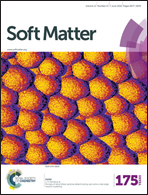Dipolar interactions between domains in lipid monolayers at the air–water interface
Abstract
A great variety of biologically relevant monolayers present phase coexistence characterized by domains formed by lipids in an ordered phase state dispersed in a continuous, disordered phase. From the difference in surface densities between these phases, inter–domain dipolar interactions arise. These interactions are relevant for the determination of the spacial distribution of domains as well as their dynamics. In this work, we propose a novel way of estimating the dipolar repulsion using a passive method that involves the analysis of images of the monolayer with phase coexistence. This method is based on the comparison of the pair correlation function obtained from experiments with that obtained from Brownian dynamics simulations of a model system. As an example, we determined the difference in dipolar density of a binary monolayer of DSPC/DMPC at the air–water interface from the analysis of the radial distribution of domains, and the results are compared with those obtained by surface potential determinations. A systematic analysis for the experimentally relevant parameter range is given, which may be used as a working curve for obtaining the dipolar repulsion in different systems.


 Please wait while we load your content...
Please wait while we load your content...